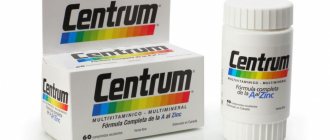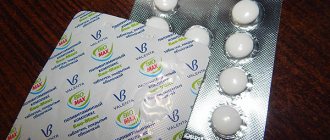Compound
Active ingredients: thiamine nitrate (vitamin b1), pyridoxine hydrochloride (vitamin b6), cyanocobalamin (vitamin b12)
1 tablet contains:
- thiamine nitrate (vitamin B1) - 15 mg;
- pyridoxine hydrochloride (vitamin B6) - 10 mg;
- cyanocobalamin (vitamin B12) - 0.02 mg.
Excipients: lactose, wheat starch, talc, magnesium stearate, silicon dioxide, povidone, Kollicoat Protect, titanium dioxide (E 171), Ponceau 4R (E 124).
Neurobeks p/o tablets in jars No. 90 No. 1
Name
Neurobeks tablet p/o in bank No. 90 in unitary enterprise No. 1
Main active ingredient
Pyridoxine + thiamine + cyanocobalamin.
Release form
Pills.
pharmachologic effect
Neurobex® is a combined preparation containing B vitamins. They are part of enzymes that catalyze metabolic reactions of carbohydrates, fats and proteins. A combination of B vitamins is used to influence a number of important processes and functions in the body and, mainly, inflammatory and degenerative diseases of the nerves and musculoskeletal system.
Indications for use
Indications for use Combined deficiency of vitamins B1, B6, B12. In the complex treatment of neurological and skin diseases and conditions associated with proven clinical or subclinical deficiency of vitamins B1, B6, B12, such as: nonspecific inflammatory and degenerative processes in peripheral nerves - neuritis, polyneuritis (alcoholic, post-infectious, toxic, diabetes); neuralgia, myalgia, paresthesia; dermatitis, eczema, psoriasis, acne vulgaris, atopic dermatitis.
Directions for use and doses
Neurobex® is taken orally during or after meals with water. The usual dose is 1-2 tablets 1-3 times a day for 30 days. The individual dose and duration of treatment are determined by the doctor. Elderly patients Usually no dose adjustment is required for elderly patients. Impaired renal function No dosage adjustment is required in patients with impaired renal function. Impaired liver function No dosage adjustment is required in patients with impaired liver function. If you have the impression that Neurobex® is too weak or too strong, consult your doctor or pharmacist. If you miss one dose of the drug, take it at your next regular dose without increasing the dose.
Use during pregnancy and lactation
There is no data on the negative effects of Neurobex on the fetus and child during pregnancy and lactation. Vitamins penetrate the placental barrier and are excreted from the body through breast milk. Due to the lack of sufficient information, the use of the drug is possible only if absolutely necessary, in recommended doses, as prescribed and under the supervision of a physician, after assessing the benefit/risk ratio, if the benefit outweighs the risk. It should be taken into account that in high doses, pyridoxine may interfere with the secretion of prolactin and should be used with caution in nursing mothers. Use in large quantities during pregnancy may lead to pyridoxine dependence syndrome in newborns.
Precautionary measures
Neurobex® should be used with extreme caution in patients with severe and acute forms of decompensated heart failure and angina. During treatment with this drug, you should not drink alcohol, since the ethanol it contains reduces the amount of vitamin B1 absorbed in the intestines. If the signs of the disease do not begin to subside, or, on the contrary, your health condition worsens, or if undesirable effects appear, consult your doctor for advice regarding further use of the drug! The tablets are not intended for use in children under 6 years of age, as this group of patients may have difficulty swallowing medications in the form of tablets and capsules.
Interaction with other drugs
If you are taking any other medications, be sure to inform your doctor about this, and if you are treating yourself, consult your doctor or pharmacist about the possibility of using the drug! Ethyl alcohol sharply reduces the absorption of vitamin B1. Vitamin B6 affects the metabolism of certain medications. Concomitant use of chloramphenicol, cycloserine, ethionamide, hydralazine, isoniazid, penicillamine, or immunosuppressants with pyridoxine may result in anemia or peripheral neuritis as these agents may act as pyridoxine antagonists or increase renal excretion of pyridoxine. Patients receiving these drugs may have increased requirements for pyridoxine. Concomitant use of estrogens may increase pyridoxine requirements. Concomitant use of levodopa with pyridoxine is not recommended because the antiparkinsonian effects of levodopa are reduced by oral pyridoxine in doses exceeding daily requirements. This problem does not arise if levodopa is combined with the peripheral decarboxylase inhibitor carbidopa. Serum levels of cyanocobalamin may be reduced by oral contraceptives. These interactions are unlikely to be of clinical significance. Antimetabolites and most antibiotics distort the results of vitamin B12 blood tests using microbiological methods. Para-aminosalicylic acid, colchicine, biguanides, neomycin, cholestyramine, potassium chloride, methyldopa and cimetidine may reduce the absorption of vitamin B12. Patients treated with chloramphenicol may respond poorly to cyanocobalamin.
Contraindications
Neurobex® is not used for: allergies to the active substances or any of the excipients in the composition of the drug; acute thromboembolism (blockage of a vessel by a blood clot); erythrocytosis and erythremia (blood diseases caused by an increase in the number of red blood cells).
Compound
Active ingredients in one coated tablet: Thiamine nitrate (vitamin B1) 15 mg, Pyridoxine hydrochloride (vitamin B6) 10 mg, Cyanocobalamin (vitamin B12) 0.02 mg. Excipients: lactose monohydrate, wheat starch, talc, magnesium stearate, colloidal silicon dioxide, povidone. Shell composition: collicoate protect (copolymer of polyvinyl alcohol and polyethylene glycol, polyvinyl alcohol, silicon dioxide), titanium dioxide, talc, cochineal red varnish E124. Information on excipients This medicinal product contains lactose as an excipient and should not be used in patients with lactase deficiency, galactose intolerance or glucose-galactose malabsorption syndrome. Due to the presence of wheat starch in the drug, it should not be taken by patients with an allergy to wheat (different from celiac disease). The medicine is suitable for patients with celiac disease (celiac disease). Dye E124, which is part of the drug, can cause allergic reactions.
Overdose
Symptoms: In case of overdose, the symptoms of side effects of the drug increase. Nervous excitement, tachycardia, and pain in the heart area may occur. Treatment: Treatment includes gastric lavage, administration of activated carbon, and the use of symptomatic agents. Isoniazid is an antidote to vitamin B6.
Side effect
Neurobex® is generally well tolerated. In rare cases, increased sweating, tachycardia, itching, and urticaria are possible. In isolated cases, allergic reactions may occur: rash, suffocation and anaphylactic shock. Severe sensory neuropathy has been described in patients taking high doses of pyridoxine (2 g to 6 g per day) for 2 to 40 months. Sensory peripheral neuropathy is also possible with prolonged use of daily doses of 200 mg or lower. If the listed adverse reactions occur, as well as reactions not listed in the instructions, you should consult a doctor.
Storage conditions
At a temperature not exceeding 25°C. Keep out of the reach of children!
Contraindications
Hypersensitivity to thiamine nitrate, pyridoxine hydrochloride, cyanocobalamin and any other components of the drug.
- Vitamin B1 is contraindicated for use in allergic diseases.
- Vitamin B6 is contraindicated for use in cases of gastric and duodenal ulcers in the acute stage (since it is possible to increase the acidity of gastric juice).
- Vitamin B12 is contraindicated for use in cases of erythremia, erythrocytosis, and thromboembolism.
Description
The effect of the drug Neurobeks is determined by the vitamins that are included in its composition:
- Thiamine (vitamin B1) is actively involved in the metabolism of carbohydrates and fats and is necessary for the synthesis of nucleic acids. Potentiates the effect of acetylcholine, which is involved in the transmission of nerve impulses. Plays an important role in regulating the functions of the muscular and autonomic nervous systems. Strengthens tissue respiration, improves oxygen supply to skin cells.
- Pyridoxine (vitamin B6) is a component necessary for the metabolism of amino acids, fats and carbohydrates, as well as for the synthesis of physiological regulators such as serotonin and histamine. Participates in the breakdown of cholesterol, synthesis and nutrition of the myelin sheath of the peripheral nerve and axon. Vitamin B6 deficiency leads to the development of neuromuscular dystrophy and court cases.
- Cyanocobalamin (vitamin B12) is involved in protein, fat and carbohydrate metabolism. Prevents fatty liver degeneration. Helps reduce cholesterol levels in the blood and remove it from blood vessels. By stimulating protein synthesis, it normalizes the processes of growth and development. Regulates hematopoietic processes. By increasing the phagocytic activity of leukocytes and activating the activity of the reticuloendothelial system, it enhances the body’s immunological defense.
The components of the Neurobeks complex are absorbed in the small intestine, bind to blood plasma proteins, and are distributed in all tissues. They undergo biotransformation in the body and are excreted mainly in the urine (both unchanged and in the form of metabolites).
Neurobex
Name: Neurobex Pharmacological action: Neurobex is a combined multivitamin preparation containing ascorbic acid and a complex of B vitamins. The vitamins included in Neurobex are coenzymes that are involved in the metabolism of lipids, proteins and carbohydrates. The B complex of vitamins provides the conditions necessary for the normalization of metabolic processes in nervous tissue: it helps improve the transmission of nerve impulses and the nutrition of neurons in subcortical structures and autonomic centers.
Vitamin B1 - thiamine nitrate - is absorbed from the digestive tract and metabolized in the liver to form an active metabolite - thiamine pyrophosphate, which decarboxylates α-ketoglutaric and pyruvic acids. Thiamine takes part in the formation of acetylcholine.
Vitamin B2 - riboflavin - is quickly absorbed from the digestive tract. Its maximum concentration is found in the kidneys, liver and myocardium. Riboflavin is able to penetrate into breast milk and through the hematoplacental barrier. Vitamin B2 takes part in the synthesis of hemoglobin and normalizes metabolism in the optic nerve. Riboflavin is absorbed and combines with adenosine triphosphoric acid, forming active metabolites: flavin adenine mononucleotide and flavin adenine nucleotide. The active metabolite of riboflavin, flavin adenine mononucleotide, is involved in the transfer of hydrogen molecules and helps normalize reductive reactions in the body. About 12% of riboflavin from the total amount in the drug is excreted by the kidneys unchanged, the rest is excreted in the form of metabolites.
Vitamin B5 - calcium pantothenate - is absorbed in the small intestine due to active transport or passive diffusion. In erythrocytes, vitamin B5 is partially biotransformed into coenzyme A, and the rest of it is determined unchanged in plasma. Calcium pantothenate is consumed in the formation of coenzyme A. It is excreted in the form of pantothenic acid (active metabolite) by the kidneys. Takes part in the anabolism of acetylcholine and glucocorticosteroids, carbohydrate and lipid metabolism. Pantothenic acid is a component of coenzyme A. Calcium pantothenate increases myocardial contractility and regeneration, improves the energy supply of cardiac muscle cells, and also potentiates the cardiotonic effect of cardiac glycosides.
Vitamin B6 - pyridoxine hydrochloride - is absorbed from the digestive tract and metabolized in the liver by phosphorylation to form the active metabolite pyridoxal-5-phosphate, which takes part in the reactions of decarboxylation and transamination of amino acids (cysteine, methionine, tryptophan, etc.). The vitamin is involved in lipid and histamine metabolism, anabolism of neurotransmitters, improves liver function, trophism of nerve fibers of the peripheral and central nervous system.
Vitamin B9 - folic acid - is biotransformed to form tetrahydrofolic acid, which is a coenzyme of many metabolic reactions. Folic acid normalizes hematopoiesis (due to the formation of normoblasts, which is caused by potentiation of the processes of transformation of megaloblasts into normocytes). Folic acid in combination with cyanocobalamin is involved in the formation of methionine, serine and other amino acids, pyrimidines, nucleinates, purines, and also stimulates erythropoiesis. Vitamin B9, as a result of its participation in choline metabolism, promotes cell regeneration. It is excreted primarily by the kidneys, and to a lesser extent by the intestines.
Vitamin B12 - cyanocobalamin - is metabolized to form an active metabolite - cobabamide, which is a growth factor for the formation of mature red blood cells. Cobabamide is necessary for blood formation. Cyanocobalamin is absorbed only with the participation of intrinsic factor of the mucous membranes of the upper intestines and stomach. Part of the untransformed cyanocobalamin is transported to organs and tissues using the transport protein transcobalamin II. Cyanocobalamin takes part in the synthesis of nucleic acids, choline, methionine, creatine. Due to its participation in the process of accumulation of sulfhydryl groups, cyanocobalamin increases the tolerance of erythrocytes to hemolysis. Vitamin B12 in adipose tissue stimulates metabolic processes, reduces cholesterol concentrations in atherosclerosis, improves the functions of nervous tissue and liver, and promotes tissue regeneration. The absorption of cyanocobalamin from the digestive tract is influenced by an external factor (glycoprotein), acid-base balance and pancreatic protease. Vitamin B12 is excreted in urine and bile, and also undergoes enterohepatic circulation.
Vitamin PP - nicotinamide - is a prosthetic part of the cohedrases NADP (triphosphopyridine nucleotide) and NAD (diphosphopyridine nucleotide). Vitamin PP, due to the participation of cohedrases in the transfer of phosphate and hydrogen, normalizes redox processes in the body. Nicotinamide is used for the specific treatment of pellagra. Able to stimulate carbohydrate metabolism, improve the condition of patients in the early stages of diabetes, with diseases of the liver, gastrointestinal tract, and heart. Due to its regenerative properties, nicotinamide is used for non-healing ulcers and wounds. Vitamin PP has vasodilating effects and hypolipidemic properties (reduces cholesterol, LDL and triglyceride levels, while increasing HDL content).
Vitamin C - ascorbic acid - normalizes redox reactions, takes part in the synthesis of steroids, collagen and procollagen, tissue regeneration, improves carbohydrate metabolism, increases blood clotting ability, improves the permeability of microcirculatory vessels. Vitamin C is rapidly absorbed from the digestive tract after the formation of dehydroascorbate. The maximum concentration is determined 4 hours after administration. Ascorbic acid immediately enters leukocytes, platelets and erythrocytes, then is transported to all tissues. Increased levels of ascorbic acid are detected in the adrenal glands. Excreted by the kidneys in the form of metabolites: oxalic acid and ascorbate-2-sulfate. Excess vitamin C can be excreted primarily unchanged by the kidneys.
Metabolism of cyanocobalamin, thiamine and pyridoxine occurs in hepatocytes. They are excreted unchanged from the body (9-10%) by the kidneys. The excess is excreted in the feces.
Indications for use: Neurobex, Neurobex-forte, Neurobex-neo is used in the treatment of: - polyneuritis of various etiologies, paresthesia, neuralgia, polyneuropathy, sciatica, lumbago, myasthenia gravis, myalgia, neurocirculatory dystonia, arthralgia; - neurogenic dermatitis, diathesis, psoriasis, herpes zoster, pyoderma, acne, eczema; - traumatic lesions of the central nervous system, encephalopathies (including Wernicke encephalopathy), spastic diseases of central origin; — asthenia (insomnia, chronic fatigue syndrome, decreased concentration and memory); - hypovitaminosis due to nutritional deficiency of B vitamins, alcoholism, anemia, leukopenia, smoking.
The drug is used as part of complex therapy for glaucoma, optic neuritis, auditory neuritis, diabetic retinopathy, degenerative processes in the retina, toxic nerve damage, gastroduodenitis, peptic ulcer, enterocolitis, liver cirrhosis, cholecystitis, hepatitis. Neurobeks is used for the rehabilitation of patients with cardiovascular diseases, myocardial dystrophy, myocarditis, cardiovascular failure, as well as after toxic damage from toxic substances.
Directions for use: Neurobex, Neurobex-forte and Neurobex-neo are taken orally during meals or after meals with water. The dosage of the drug and the duration of therapy are determined individually. Neurobex for prophylactic use is prescribed 1-2 tablets three times a day for 1 month. For diseases of the nervous system, Neurobeks is prescribed to adults and adolescents from 14 years old, 2 tablets three times a day, children 8-14 years old - 1 tablet two or three times a day, children 3-8 years old - once or twice a day, 1 tablet. Nursing and pregnant women are prescribed 1 Neurobex tablet 1-2 times a day. As part of complex therapy, Neurobeks is prescribed to adults and adolescents over 14 years old, three times a day, 1 tablet, children 8-14 years old - two or three times a day, 1 tablet, children 3-8 years old - once or twice a day, 1 tablet . Nursing and pregnant women are prescribed 1 Neurobex tablet 1-2 times a day.
When treating asthenic syndrome, Neurobex is prescribed to adults and adolescents from 14 years of age, 1 tablet three times a day, children 8-14 years old - 1 tablet twice a day, children 3-8 years old - 1 tablet once a day. Nursing and pregnant women are prescribed 1 Neurobex tablet 1-2 times a day. Neurobex-Forte is prescribed only to adults and adolescents over 14 years of age. For preventive use, it is recommended to take Neurobeks-forte once a day, 1 tablet for 1 month. In the treatment of neurological diseases and asthenic syndrome, Neurobeks-forte is prescribed 1-2 tablets. per day. Nursing and pregnant women are prescribed 1 tablet of Neurobex-Forte per day. Neurobeks-neo is prescribed once a day, 1 capsule for 2-4 weeks, if necessary, the duration of therapy is increased. When treating neurological diseases, it is recommended to take 1-2 capsules of Neurobeks-neo per day.
Side effects: When using Neurobex, nausea, individual hypersensitivity to the components of the drug, and allergic reactions may occur (rarely).
Contraindications: Neurobex, Neurobex-forte, Neurobex-neo are contraindicated in patients with acute thromboembolism, erythremia, erythrocytosis, allergies or hypersensitivity to the components of the drug.
Pregnancy: Neurobex-forte, Neurobex can be prescribed during pregnancy, but provided that the potential risk to the fetus does not exceed the expected benefit to the mother. The safety and effectiveness of Neurobeks-neo in pregnant women has not been studied.
Interaction with other drugs: Concomitant use of pyridoxine and levodopa may lead to a decrease in the antiparkinsonian effect of the latter. Hydralazine, thiosemicarbazone, isoniazid and serine are pyridoxine antagonists. Concomitant use of pyridoxine with hormonal contraceptives may lead to a decrease in the concentration of pyridoxine in the blood. Pyridoxine, when taken simultaneously, may reduce the therapeutic effect of phenytoin and phenobarbital.
Simultaneous use of Neurobex with hormonal contraceptives, alcohol, and diuretics reduces the effect of the drug on the nervous system. The simultaneous use of Neurobex and drugs that regulate the secretion of pancreatic enzymes and antihypertensive drugs leads to potentiation of the conversion of riboflavin into coenzymes. Under the influence of neuroleptics and peripheral vasodilators, the metabolism of riboflavin slows down. Calcium pantothenate, when taken simultaneously, potentiates the effect of cardiac glycosides, reduces the toxic effect of streptomycin and other antibiotics used to treat tuberculosis. Neurobex should not be combined with drugs that contain aluminum (vitamin C can increase the absorption of aluminum from the digestive tract).
Overdose: Exceeding the dosage of Neurobex can lead to the development of agitation, palpitations, chest pain, diarrhea, and increased side effects. Treatment of overdose: Isoniazid (pyridoxine antidote) can be used as an antidote. Symptomatic therapy is carried out.
Release form: Neurobex tablets Pack contains 30 tablets, 60 tablets. Neurobeks-forte tablets p/o There are 30 tablets in a package. Neurobeks-neo capsules Pack contains 30 capsules, 60 capsules.
Storage conditions: The storage temperature of the drug should not exceed 25 degrees Celsius. Keep away from light. Keep away from children.
Composition: 1 dragee of Neurobex contains: 15 mg of thiamine nitrate, 10 mg of pyridoxine hydrochloride, 0.02 mg of cyanocobalamin.
1 tablet of Neurobex-forte contains: 100 mg of thiamine, 200 mg of pyridoxine, 300 mg of cyanocobalamin. 1 capsule of Neurobex-neo contains: 50 mg of thiamine, 25 mg of riboflavin, 100 mg of nicotinamide, 25 mg of calcium pantothenate, 0.5 mg of folic acid, 200 mg of pyridoxine, 300 mg of cyanocobalamin, 175 mg of ascorbic acid.
Excipients: cellulose acetophthalate, colloidal silicon dioxide, Eurolake ponceau dye, macrogol 400, lactose monohydrate, glycerol, magnesium stearate, macrogol 6000, talc, sugarpovidone K 25, gum arabic, wheat starch.
Additionally: The drug should be prescribed with caution to patients with coronary artery disease due to the content of cyanocobalamin. The drug does not affect the reaction rate.
Attention! The description of the drug " Neurobeks " on this page is a simplified and expanded version of the official instructions for use. Before purchasing or using the drug, you should consult your doctor and read the instructions approved by the manufacturer. Information about the drug is provided for informational purposes only and should not be used as a guide to self-medication. Only a doctor can decide to prescribe the drug, as well as determine the dose and methods of its use.
Indications for use
In the complex treatment of neuritis, polyneuritis and neuralgia, such as:
- trigeminal neuralgia
- intercostal neuralgia;
- Isias;
- lumbar syndrome (lumbago)
- plexitis (cervical and brachial plexuses)
- radicular neuritis due to degenerative diseases of the spine;
- prosoplegia (facial nerve damage)
- post-infectious and toxic damage to nervous tissue due to alcoholism, diabetic polyneuropathy, drug intoxication.
special instructions
Use during pregnancy or breastfeeding
The drug should be prescribed only after a careful assessment of the balance of benefit for the mother and the risk to the fetus, since there is insufficient data on the safety of the drug during pregnancy.
Vitamins B1, B6 and B12 are excreted into breast milk. Large concentrations of vitamin B6 may suppress lactation. Studies on the degree of secretion of vitamins into breast milk have not been conducted. The decision to discontinue breastfeeding or use of the drug must be made taking into account the need for the drug for the mother. If it is necessary to use the drug, you should stop breastfeeding for this period.
Children
The drug should not be prescribed to children.
Note!
Description of the drug Neurobeks-Teva table. p/o No. 90 on this page is a simplified author’s version of the apteka911 website, created on the basis of the instructions for use.
Before purchasing or using the drug, you should consult your doctor and read the manufacturer's original instructions (attached to each package of the drug). Information about the drug is provided for informational purposes only and should not be used as a guide to self-medication. Only a doctor can decide to prescribe the drug, as well as determine the dose and methods of its use.





